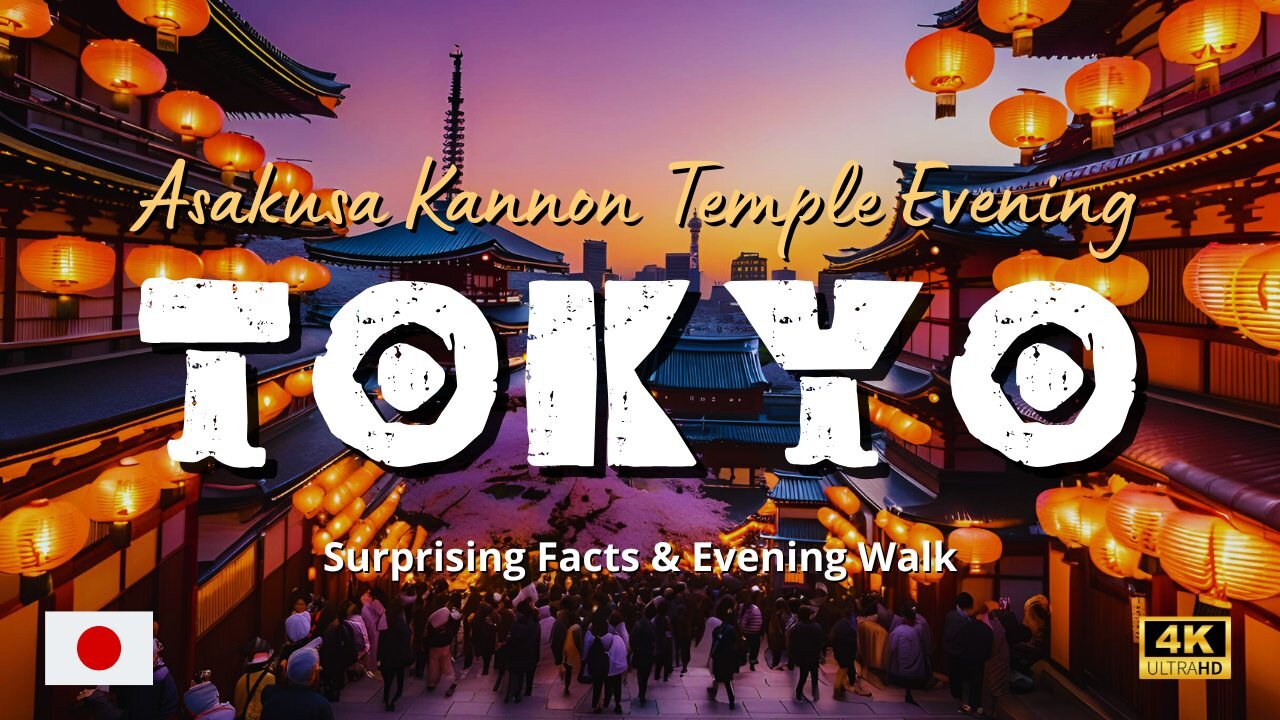Premium Only Content

Asakusa Kannon Temple Evening Walking Tour | Rare Facts & Hidden Gems
1.
The temple's origins are tied to a miraculous event in 628 CE. Two fishermen, Hinokuma Hamanari and his brother Takenari, found a statue of Kannon, the Buddhist goddess of mercy, in the Sumida River while fishing. Despite returning it to the river, the statue kept returning to them, which was seen as a divine sign. A local village chief, Hajino Nakamoto, recognized the significance of the statue and decided to convert his home into a temple to honor Kannon. This led to the founding of Senso-ji, making it Tokyo’s oldest temple.
2.
The temple complex was heavily bombed during World War II and suffered significant damage, but the main hall (Hondo) and other structures were rebuilt in 1958. The temple’s rebuilding after the war became a symbol of Japan's resilience and spiritual rebirth. It is interesting to note that despite this destruction, the Thunder Gate (Kaminarimon), which serves as the entrance to the temple, remained largely intact.
3.
The Kaminarimon, or "Thunder Gate," is an iconic feature of the temple, but few know that the giant lantern hanging under it weighs approximately 700 kilograms (over 1,500 pounds). The lantern is replaced every decade or so due to wear, and it takes skilled craftsmen weeks to produce each new one. The current lantern was donated by Panasonic's founder, Konosuke Matsushita, in 1960, reflecting the temple’s connection to corporate patronage.
4.
Located within the temple complex is Asakusa Shrine, a Shinto shrine built in 1649 that is dedicated to the two fishermen who found the statue and to the village chief who founded the temple. Although it stands side-by-side with Senso-ji, Asakusa Shrine is a Shinto shrine, not Buddhist, reflecting the syncretism of Buddhism and Shinto in Japan’s religious history. During the Meiji Restoration (1868), the government attempted to separate Shinto and Buddhism, but both remain intertwined here.
5.
Senso-ji is particularly famous for omikuji, a form of fortune-telling. Visitors shake a metal cylinder and pull out a stick that corresponds to a numbered fortune slip. Senso-ji’s omikuji is known to be "harsh," meaning that many people often receive a “bad fortune” (凶, "kyo"). However, the temple allows people to tie their bad fortunes to a nearby rack, believed to negate the unlucky outcome.
6.
Despite its ancient origins, Senso-ji is located in the heart of modern Tokyo, surrounded by bustling shopping streets such as Nakamise-dori, which sells traditional Japanese snacks, souvenirs, and crafts. This juxtaposition of sacred history and urban life makes the temple a unique cultural bridge between the past and present.
7.
The five-story pagoda of Senso-ji is another notable feature. Interestingly, it is not just a symbol of Buddhist enlightenment but also serves as a reliquary, housing relics of the Buddha. These relics were given as a gift by Sri Lanka in the 1960s, adding an international dimension to the temple’s religious significance.
8.
Every July, the temple hosts the Hozuki-ichi (Ground Cherry Pod Market), during which visitors purchase hozuki plants, believed to have spiritual properties that can bring good luck. At the same time, the Shiman-rokusen-nichi Festival takes place, which is unique to Senso-ji. Attendees believe that praying at the temple on this day is equivalent to visiting the temple for 46,000 days!
9.
The large bronze incense burner (Jokoro) in front of the main hall is where visitors gather to waft the incense smoke over themselves. The smoke is believed to have healing properties, and you will often see people wafting it towards parts of their body that need healing or good fortune, such as over their head for wisdom or over an injury for faster recovery.
10.
In the Edo period, the temple became closely associated with the rise of Kabuki theater, a classical form of Japanese drama. The Asakusa district was home to many Kabuki theaters, and actors would visit the temple to pray for success. Even today, Kabuki actors often make pilgrimage visits to Senso-ji before performances, keeping alive a centuries-old tradition.
I WILL BE VERY INSPIRED IF YOU BUY ME A COFFEE: https://www.buymeacoffee.com/MoiseiAn...
Video from: #Tokyo #Japan #travel #asakusa
Video title: Asakusa Kannon Temple Evening Walking Tour | Rare Facts & Hidden Gems
Time of filming: 15.08.2024
Video resolution: 4K UHD
Producer: Andreii Moiseii (Instagram @moiseii_production)
-
 21:42
21:42
SLS - Street League Skateboarding
10 days agoLuan Oliveira's Top SLS Moments: 2013 & 2014
3.95K1 -
 LIVE
LIVE
Dr Disrespect
3 hours ago🔴LIVE - DR DISRESPECT - WARZONE - ATTACK ATTACK ATTACK
2,985 watching -
 LIVE
LIVE
Grant Stinchfield
21 hours agoCollege Sports Crisis? Athletic Directors Beg Congress to Step In on Athlete Pay Chaos
113 watching -
 1:02:27
1:02:27
Timcast
2 hours agoDemocrats PANIC As MS-13 SUpport BACKFIRES, Senator DROPS Support For Abrego Garcia
119K112 -
 1:55:36
1:55:36
The Charlie Kirk Show
2 hours agoThe Next Pope? + Second Signal Chat + Maher Aftermath | Knowles, Marlow, Turek | 4.21.25
38.4K16 -

BitLab Academy
4 hours ago $0.69 earnedCrypto Mega Pump Signal Flashing | Bitcoin Breakout, Altcoin Alt Season Starting?
13.3K2 -
 1:05:04
1:05:04
Rebel News
2 hours ago $1.00 earnedEzra Levant REACTS: Rebel's debate victory, CBC lies corrected | Q&A Livestream
13.2K3 -
 19:55
19:55
Neil McCoy-Ward
1 hour ago💥 The Unthinkable Is Starting To Happen (And Why It Has Dire Consequences)
10.4K5 -
 1:02:25
1:02:25
Steven Crowder
5 hours ago🔴 Globalist Cities: A New World Order
254K335 -
 19:39
19:39
The White House
3 hours agoFirst Lady Melania Trump Reads to Children at the 2025 White House Easter Egg Roll
27.1K11